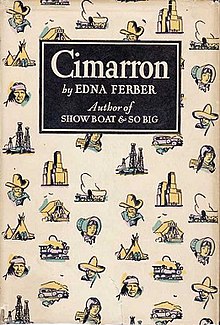
Edna Ferber was an American novelist, short story writer and playwright. Her novels include the Pulitzer Prize-winning So Big (1924), Show Boat, Cimarron, Giant and Ice Palace (1958), which also received a film adaptation in 1960. She helped adapt her short story "Old Man Minick", published in 1922, into a play (Minick) and it was thrice adapted to film, in 1925 as the silent film Welcome Home, in 1932 as The Expert, and in 1939 as No Place to Go.
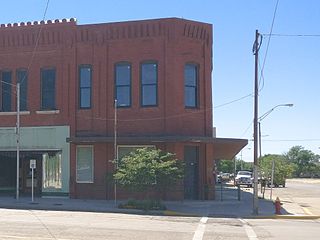
Woods County is a county located in the northwestern part of the U.S. state of Oklahoma. As of the 2020 census, the population was 8,624. Its county seat is Alva. The county is named after Samuel Newitt Wood, a renowned Kansas populist.

Pawnee County is a county located in the U.S. state of Oklahoma. As of the 2020 census, the population was 15,553. Its county seat is Pawnee. The county is named after the Pawnee Nation, whose reservation used to encompass the county prior to allotment in 1893.

Noble County is located in the north central part of Oklahoma. As of the 2020 census, the population was 10,924. Its county seat is Perry. It was part of the Cherokee Outlet in Indian Territory until Oklahoma Territory was created in 1890, and the present county land was designated as County P. After the U. S. government opened the area to non-Indian settlement in 1893, it was renamed Noble County for John Willock Noble, then the United States Secretary of the Interior.

Newkirk is a city and county seat of Kay County, Oklahoma, United States. The population was 2,172 at the 2020 census.

Pawhuska is a city in and the county seat of Osage County, Oklahoma, United States. As of the 2020 census, the population of the city was 2,984. It was named after the 19th-century Osage chief, Paw-Hiu-Skah, which means "White Hair" in English. The Osage tribal government, which opened offices in Pawhuska in 1872 when its reservation was established in Indian Territory, continues to be based in Pawhuska.

Richard Dix was an American motion picture actor who achieved popularity in both silent and sound film. His standard on-screen image was that of the rugged and stalwart hero. He was nominated for the Academy Award for Best Actor for his lead role in the Best Picture-winning epic Cimarron (1931).

A land run or land rush was an event in which previously restricted land of the United States was opened to homestead on a first-arrival basis. Lands were opened and sold first-come or by bid, or won by lottery, or by means other than a run. The settlers, no matter how they acquired occupancy, purchased the land from the United States General Land Office. For former Indian lands, the Land Office distributed the sales funds to the various tribal entities, according to previously negotiated terms. The Oklahoma Land Rush of 1889 was the most prominent of the land runs while the Land Run of 1893 was the largest. The opening of the former Kickapoo area in 1895 was the last use of a land run in the present area of Oklahoma.

The Cherokee Outlet, or Cherokee Strip, was located in what is now the state of Oklahoma in the United States. It was a 60-mile-wide (97 km) parcel of land south of the Oklahoma–Kansas border between 96 and 100°W. The Cherokee Outlet was created in 1836. The United States forced the Cherokee Nation of Indians to cede to the United States all lands east of the Mississippi River in exchange for a reservation and an "outlet" in Indian Territory. At the time of its creation, the Cherokee Outlet was about 225 miles (360 km) long. The cities of Enid, Woodward, Ponca City, and Perry were later founded within the boundaries of what had been the Cherokee Outlet.
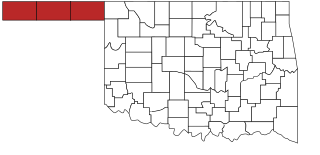
The Oklahoma Panhandle is a salient in the extreme northwestern region of the U.S. state of Oklahoma, consisting of Cimarron County, Texas County and Beaver County, from west to east. As with other salients in the United States, its name comes from the similarity of its shape to the handle of a pan.
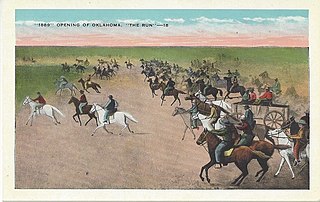
The Oklahoma Land Rush of 1889 was the first land run into the Unassigned Lands of former Indian Territory, which had earlier been assigned to the Creek and Seminole peoples. The area that was opened to settlement included all or part of the Canadian, Cleveland, Kingfisher, Logan, Oklahoma, and Payne counties of the present-day US state of Oklahoma.
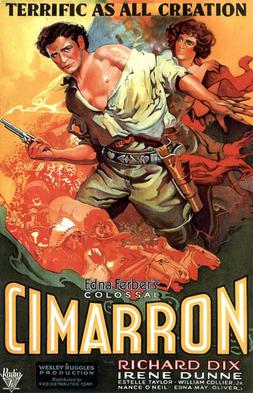
Cimarron is a 1931 pre-Code epic Western film starring Richard Dix and Irene Dunne, and directed by Wesley Ruggles. Released by RKO, it won Academy Awards for Best Picture, Best Adapted Screenplay, and Best Production Design.
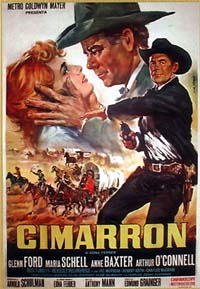
Cimarron is a 1960 American epic Western film based on the Edna Ferber novel Cimarron. The film stars Glenn Ford and Maria Schell and was directed by Anthony Mann and Charles Walters, though Walters is not credited onscreen. Ferber's novel was previously adapted as a film in 1931; that version won three Academy Awards.

Tumbleweeds is a 1925 American silent Western film starring and produced by William S. Hart. It depicts the Cherokee Strip land rush of 1893. The film is said to have influenced the Oscar-winning 1931 Western Cimarron, which also depicts the land rush. The 1939 Astor Pictures' re-release of Tumbleweeds includes an 8-minute introduction by the then 75-year-old Hart as he talks about his career and the "glories of the old west." Tumbleweeds was Hart's last movie.

Temple Lea Houston was an American attorney and politician who served from 1885 to 1889 in the Texas State Senate. He was the last-born child of Margaret Lea Houston and Sam Houston, the first elected president of the Republic of Texas.

In U.S. history, the Land Run of 1893, also known as the Cherokee Outlet Opening or the Cherokee Strip Land Run, marked the opening to settlement of the Cherokee Outlet in the Oklahoma Territory's fourth and largest land run. It was part of what would later become the U.S. state of Oklahoma in 1907.
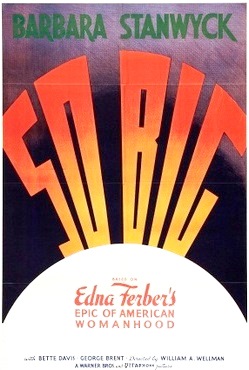
So Big is a 1932 pre-Code American drama film directed by William A. Wellman and starring Barbara Stanwyck. The screenplay by J. Grubb Alexander and Robert Lord is based on the 1924 Pulitzer Prize-winning novel of the same name, by Edna Ferber.
Cravat, cravate or cravats may refer to:
Elva Shartel Ferguson was an American newspaper editor who served as the First Lady of Oklahoma Territory between 1901 and 1906 during the tenure of her husband Thompson Benton Ferguson.
